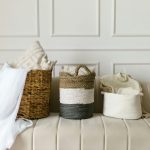You can definitely choose velvet for your sofa or high-use furniture if you pick the right type and care for it well. Synthetic or performance velvets are durable, stain-resistant, and stand up better to daily wear than natural fibers like cotton or silk velvet. Opt for shorter pile velvet and darker colors to hide dirt and damage. With proper vacuuming, brushing, and quick stain treatment, velvet can stay beautiful. Explore more to find the best options and care tips for your lifestyle.
Table of Contents
Key Takeaways
- Synthetic velvet fabrics are more durable and stain-resistant, making them better suited for high-use sofas and active households.
- Shorter pile velvet with denser weaves resists wear and hides stains, ideal for furniture in busy living areas.
- Natural fiber velvets like cotton and silk offer luxury but require careful maintenance and are less durable for heavy use.
- Regular care, including vacuuming and prompt stain treatment, is essential to maintain velvet’s appearance and longevity on sofas.
- Velvet is best for low to moderate use furniture; consider lifestyle and maintenance willingness before choosing velvet for high-traffic pieces.
Understanding Velvet Fabric and Its Varieties
Velvet fabric offers a luxurious texture that can transform any sofa into a statement piece. When you choose velvet, you’re picking from a range of varieties, each with unique qualities.
Crushed velvet has a shiny, crumpled look that adds depth, while panne velvet boasts a smooth, sleek finish. You’ll also encounter cotton velvet, which feels soft and breathable, and silk velvet, prized for its rich sheen and delicate touch.
Synthetic velvets, like polyester or nylon blends, are durable and stain-resistant, making them practical choices. Knowing these varieties helps you select velvet that suits your style and lifestyle.
Each type feels different and behaves uniquely under wear, so understanding these options guarantees your sofa remains both beautiful and comfortable.
Factors Affecting Velvet’s Durability
You’ll find that the type of fiber in velvet greatly influences its durability, with some fibers standing up to wear better than others.
How velvet is woven and finished also plays a vital role in how well it holds up over time.
Understanding these factors helps you choose a velvet sofa that lasts longer and stays beautiful.
Fiber Type Impact
Although the look and feel of velvet can captivate you, its durability largely depends on the type of fibers used in its construction.
Choosing the right fiber can make a big difference in how well your velvet sofa holds up over time. Here are three key fiber types you should consider:
- Cotton Velvet – Soft and breathable but less resistant to wear and prone to crushing under heavy use.
- Silk Velvet – Luxurious and smooth but delicate, requiring careful maintenance to avoid damage.
- Synthetic Velvet (Polyester or Nylon) – Highly durable and stain-resistant, making it ideal for high-traffic furniture.
Weave and Finish
The type of fibers in your velvet sofa sets the foundation, but how those fibers are woven and finished plays a big role in durability too.
When choosing velvet, look for a tight weave; it resists wear better and keeps the fabric looking fresh longer. Velvet made with a cut pile weave tends to be softer but may show marks from heavy use, while a woven pile velvet is more durable and less prone to crushing.
The finishing process also matters—a well-finished velvet will have treatments that protect against stains and fading.
If you want a velvet sofa for high-use areas, opt for velvet with a sturdy weave and a quality finish. This combo helps your sofa stand up to daily wear without losing its luxurious feel.
Comparing Velvet to Other Upholstery Fabrics
When choosing upholstery fabric for your sofa, you’ll want to weigh how velvet stacks up against other options like cotton, linen, and leather.
Velvet offers a rich texture and luxurious look but differs in durability and maintenance. Here’s how velvet compares:
Velvet brings a luxurious feel with unique durability and care needs compared to other fabrics.
- Cotton: Breathable and easy to clean, but less durable under heavy use than velvet. It may fade faster and wrinkle.
- Linen: Offers a natural, casual feel but is prone to staining and wrinkling, requiring more upkeep than velvet.
- Leather: Extremely durable and easy to wipe clean, but it lacks the softness and warmth velvet provides and can be prone to scratches.
Understanding these differences helps you pick a fabric that balances style with the practical demands of your living space.
Common Types of Velvet Used for Furniture
When choosing velvet for your sofa, you’ll notice cotton velvet offers a soft feel and natural breathability.
On the other hand, synthetic velvet provides greater durability and stain resistance.
Understanding these differences helps you pick the best option for your furniture’s needs.
Cotton Velvet Characteristics
Although cotton velvet may not be as heavy-duty as synthetic alternatives, it offers a soft, breathable texture that many find appealing for sofas.
When you choose cotton velvet, keep these key characteristics in mind:
- Comfort: Cotton velvet feels smooth against the skin, making it an inviting choice for lounging.
- Breathability: Its natural fibers allow air circulation, reducing heat buildup during long use.
- Care Requirements: Cotton velvet tends to absorb stains easily and may fade in direct sunlight, so it needs gentle cleaning and protection from harsh conditions.
If you prioritize comfort and natural materials over extreme durability, cotton velvet can be a lovely option for your furniture, especially in low to moderate use areas.
Synthetic Velvet Benefits
Because synthetic velvets combine durability and style, they’ve become a popular choice for sofas that face frequent use.
When you pick synthetic velvet, you get fabrics like polyester, nylon, or a blend, which resist wear, stains, and fading far better than natural fibers. This means your sofa maintains its vibrant look even after countless gatherings or daily lounging.
Plus, synthetic velvet often feels soft and plush, giving you comfort without sacrificing strength. You’ll also find it easier to clean—most synthetic velvets handle spot cleaning well and don’t require special care.
How Velvet Performs in High-Traffic Areas
If you’re evaluating velvet for a sofa in a busy room, you’ll want to know how it handles constant use. Velvet can perform well in high-traffic areas, but its durability depends on the type and quality.
Here’s what you need to take into account:
- Fiber Content: Synthetic velvets like polyester resist wear better than natural fibers, making them more suitable for frequent use.
- Pile Density: A denser pile means the fabric will hold up longer under regular pressure and maintain its plush appearance.
- Color and Pattern: Darker colors and patterned velvets tend to show less wear and stains, helping your sofa look fresh despite heavy use.
Maintenance Tips to Extend Velvet’s Lifespan
Knowing how velvet holds up in busy spaces helps you understand why proper care makes a big difference. To keep your velvet sofa looking fresh, regular maintenance is key. Vacuum gently with a soft brush attachment to remove dust without crushing the pile. Rotate cushions frequently to prevent uneven wear. Keep velvet away from direct sunlight to avoid fading.
Here’s a simple maintenance guide:
| Task | Frequency | Tips |
|---|---|---|
| Vacuuming | Weekly | Use soft brush attachment |
| Cushion Rotation | Weekly | Flip and rotate cushions |
| Sunlight Exposure | Avoid daily | Use curtains or blinds |
| Brushing | Monthly | Use a soft velvet brush gently |
Follow these steps to extend your velvet’s lifespan effectively.
Dealing With Stains and Wear on Velvet Upholstery
When stains or wear appear on your velvet upholstery, prompt and careful action can prevent lasting damage. Velvet’s delicate texture means you should treat stains gently and avoid harsh scrubbing.
Here’s how to handle common issues:
- Blot stains immediately with a clean, dry cloth to absorb excess liquid without rubbing.
- Use a mild soap solution or a velvet-specific cleaner, applying it sparingly with a soft cloth.
- For wear, brush the fabric gently with a soft-bristle brush to lift crushed fibers and restore the nap.
Avoid soaking velvet or using abrasive tools, as these can worsen damage.
Regular attention to stains and wear helps keep your velvet sofa looking fresh and luxurious longer.
Best Velvet Options for Families and Pets
Choosing the right velvet for a home with kids or pets means balancing softness with durability.
Look for velvet made from synthetic fibers like polyester or nylon—they resist stains and wear better than natural fibers. Performance velvets are designed specifically for high-traffic areas; they often have a stain-resistant finish and hold up well to frequent cleaning.
Consider velvets with a shorter pile, as they’re less likely to show marks or attract pet hair. Darker colors or patterned velvet can also help hide everyday dirt and wear.
Shorter pile velvet in darker or patterned colors helps conceal marks and pet hair for everyday durability.
While velvet is luxurious, opting for these family-friendly options guarantees your furniture stays beautiful longer, even with active use. With the right velvet choice, you don’t have to sacrifice comfort for practicality.
When to Choose Velvet for Your Sofa or Furniture
Wondering if velvet is the right fabric for your sofa or furniture? Velvet works best when you want to combine luxury with comfort, but it’s not always ideal for heavy wear.
Consider these points before choosing velvet:
- Low to Moderate Use Areas: Velvet shines in spaces where your furniture won’t face constant heavy traffic, like formal living rooms or guest bedrooms.
- Aesthetic Priority: If you want a rich, elegant look that adds texture and depth to your décor, velvet delivers unmatched visual appeal.
- Willingness to Maintain: Velvet requires regular care to prevent crushing and stains, so pick it if you’re ready to invest time in upkeep.
Choosing velvet means balancing beauty with practicality, so assess your lifestyle before deciding.
Frequently Asked Questions
Can Velvet Fabric Be Recycled or Is It Environmentally Sustainable?
You can recycle velvet fabric, but it’s tricky due to mixed fibers and treatments. While not always eco-friendly, choosing velvet made from natural or recycled materials boosts sustainability, helping you reduce environmental impact with smarter fabric choices.
How Does Velvet Fabric Affect Indoor Air Quality?
Velvet fabric can act like a gentle sponge, trapping dust and allergens, which might affect your indoor air quality. You’ll want to clean it regularly to keep your space fresh and breathe easy.
Are There Hypoallergenic Velvet Fabric Options Available?
You can find hypoallergenic velvet fabrics made from natural fibers like cotton or bamboo, which reduce allergens. Just check product labels and certifications to verify they meet your needs, helping keep your space comfortable and allergy-friendly.
What Is the Average Cost Range for Velvet Upholstery per Yard?
You might think velvet is pricey, but it’s often worth it. Velvet upholstery typically costs between $30 and $100 per yard, depending on the quality and fiber type, so you can find options to suit your budget.
Can Velvet Upholstery Be Professionally Reupholstered Easily?
You can have velvet upholstery professionally reupholstered fairly easily. Skilled upholsterers know how to handle its delicate texture, ensuring the fabric stays smooth and vibrant while fitting perfectly on your furniture.
- Does Lyocell Recover From Stretch? Fabric Elasticity Explained - July 14, 2025
- Is Lyocell Warm Enough for Winter? How to Layer It for Cold Weather - July 14, 2025
- Does Lyocell Need Ironing? How to Have Wrinkle-Free Lyocell - July 14, 2025







